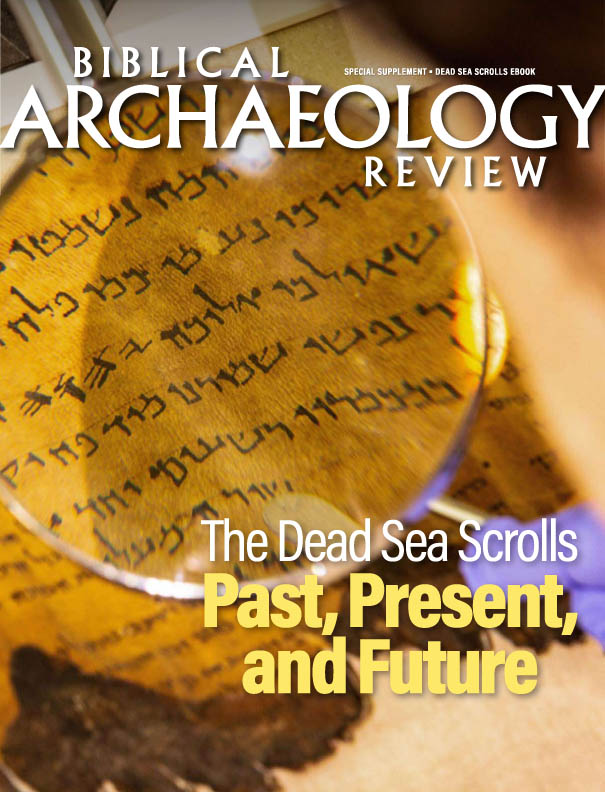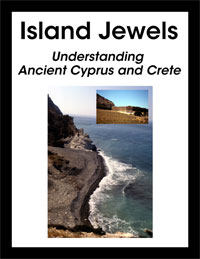The post The Vanilla Enigma: How a Canaanite Tomb Rewrote Spice History appeared first on Biblical Archaeology Society.
]]>
Aerial view of Tel Megiddo in northern Israel, where the earliest evidence of the use of vanilla in the world was discovered. Courtesy Photo Companion to the Bible, Joshua.
What do you and a 3,600-year-old Canaanite have in common? You both have used vanilla. The discovery of vanilla-laced wine in Iron Age Jerusalem caused no small commotion. After all, vanilla was only domesticated in the 12th century CE, in Mesoamerica. So, how could the spice appear nearly two thousand years earlier and half a world away from where it was domesticated? This is where that 3,600-year-old Canaanite comes in. Located only fifty-five miles north of Jerusalem, and a thousand years earlier than the flavored wine found there, is the oldest known use of vanilla ever discovered, predating the plant’s Mesoamerican domestication by two and a half millennia.

FREE ebook: The Galilee Jesus Knew
As Canaanite as Vanilla
While analyzing the chemical residue left on a series of small pots from an elite burial tomb, dating to 1650–1550 BCE, the archaeological team made a startling discovery: significant amounts of vanillin, a primary flavor and aroma compound in vanilla. They also noticed several other chemical compounds known to come from true vanilla. Although vanilla might be no more than a cliché term for “common” or “unremarkable” today, this discovery was anything but. Found at the biblical site of Megiddo in northern Israel, the discovery goes against everything we thought we knew about vanilla and its origins. To get to the bottom of this conundrum, the team set out to figure out just what they had found.
In nature, trace amounts of vanillin can come from a wide range of sources, including some yeasts, fungi, and bacteria. It can even come from different aromatic resins, a few of which are native to the eastern Mediterranean. Yet, in each case, when compared to the results of their analysis, these other sources did not match the Megiddo samples. Even if the other sources contained vanillin, none of them had the full range of compounds found in the sample, and what they did have was not in the same ratios. Double-checking that their tests had not produced a faulty chemical signal due to contamination, the team came back to the seemingly impossible option: it was real vanilla. However, proving that what they found must be real vanilla was only part of the conundrum. How did it get to Megiddo?

FREE ebook, Recipes from the BAR Test Kitchen Make your own food from recipes handed down from biblical times. Download now.
Today, nearly all vanilla on the market can trace its origins back to a single species of vanilla orchid, vanilla planifolia. This plant was first cultivated in Mesoamerica around the 12th century, although wild vanilla was probably used in the area long before that. However, vanilla planifolia is not the only species of vanilla orchid. Indeed, various species of vanilla orchid are endemic to tropical regions across the globe, although only a handful are considered aromatic, and thus capable of producing what we know as vanilla. At least four of these are found outside of the Americas, with three species native to Southeast Asia and India, and one native to East Africa. Today, some local communities in these areas still grow or collect these vanilla orchids for use in food, medicines, and fragrances.

The orchid of vanilla planifolia, the primary species of vanilla in use today. Vanillinmacher, Attribution, via Wikimedia Commons
While these regions are still far away from the land of Canaan, by the second millennium BCE, many long-distance trade networks were already established, connecting the major urban centers of the day, including Egypt, Mesopotamia, Anatolia, and the Indus River Valley. Evidence of this far-reaching trade system can even be seen in the use of peppercorns from India in the mummification of Pharaoh Ramesses the Great. While the Levant was certainly not one of the great urban centers during this period, it had the fortune of being located along the trade routes running from Africa and Egypt to the rest of the Near East and beyond.
According to Vanessa Linares of the University of Haifa, lead author of the study, “Israel’s location at the crossroads of ancient trade routes likely facilitated the importation of exotic goods, including vanilla, from regions such as Southeast Asia or East Africa. The coastal and inland trade routes in Israel, such as those passing through Megiddo, would have made it an ideal location for the introduction and exchange of rare commodities like vanilla.”
Become a BAS All-Access Member Now!
Read Biblical Archaeology Review online, explore 50 years of BAR, watch videos, attend talks, and more

The tomb in which the vanilla was discovered was already a fantastic discovery due to its rich assemblage of material culture, including imported ceramics, jewelry, and other funerary offerings. But the vanilla was by far the most impressive find. It was likely used somehow in the funerary activities associated with the interment of the individuals laid to rest in the tomb, as vanilla combined its desirable fragrance with antifungal and antibacterial properties. As such, it might have been used for embalming, much like the Egyptian “scent of eternity,” which contained several similar compounds.
One question remains. With vanilla discovered in several archaeological contexts in Israel, why has it not been found elsewhere? “It’s important to consider the nature of the archaeological record and the specific trade routes that existed at the time,” said Linares. “Vanilla might have been imported and used in Israel due to its proximity to Egypt and other trading centers. Furthermore, organic residue analysis is still an under-researched field and is not automatically incorporated into every archaeological discovery. As the application of organic residue analysis becomes more routine in excavations around the world, we are likely to see an increasing number of exotic commodities like vanilla being identified in other regions.”
Related reading in Bible History Daily
Early Bronze Age: Megiddo’s Great Temple and the Birth of Urban Culture in the Levant
All-Access members, read more in the BAS Library
Not a BAS Library or All-Access Member yet? Join today.
The post The Vanilla Enigma: How a Canaanite Tomb Rewrote Spice History appeared first on Biblical Archaeology Society.
]]>The post Mysterious Tombs Reveal Insights into Ancient Trade appeared first on Biblical Archaeology Society.
]]>
Aerial photo of one of the mysterious tombs. Courtesy Emil Aladjem, IAA.
At the crossroads of ancient trade routes running through the Negev Desert, archaeologists with the Israel Antiquities Authority (IAA) discovered a complex of mysterious tombs dating from the seventh through fifth centuries BCE. Among the ruins, the team discovered evidence that passing caravans came from as far away as ancient South Arabia (modern Yemen), trading in frankincense, myrrh, and possibly even trafficked women.

The eBook, The Dead Sea Scrolls: Past, Present, and Future, brings together articles and interviews with the world’s leading experts on the scrolls. Receive your free copy today!
The Desert Spice Route
Discovered near Tlalim junction in the northern Negev Desert, the site consists of two tombs separated by a courtyard. Although not close to any permanent settlements, the tombs sat at the crossroads of two important ancient trade routes, the Scorpion Ascents and the Way of the Sultan, which connected Egypt and Phoenicia to the Arabian Peninsula from at least the third millennium BCE. It was sometime between the seventh and fifth centuries BCE, however, that the two tombs were constructed, likely by merchants passing along the desert route.
Among the tombs, archaeologists uncovered a large number of artifacts from across the region. These included Judahite and Edomite pottery, Egyptian amulets and scarabs, alabaster vessels, flint arrowheads, and stone incense burners from South Arabia. The alabaster vessels, each with a lid, would have been used to transport incense such as frankincense and myrrh, as alabaster was thought to be the best way to preserve incense.
The archaeologists also found copper and silver jewelry, hundreds of colorful stone beads, and rare shells. Most of the artifacts were uncovered inside the tombs and had likely been deposited as grave goods. “The discovery is unique,” said Martin Pasternak, the director of the IAA’s excavation, and Tali Erickson-Gini, a senior researcher. “It points to wide-reaching cultural interchange between southern and northern Arabia, Phoenicia, Egypt, and southern Europe. The great variety of finds is evidence that this previously unknown site was a place of burial for trade caravans during that period and burial and cultic practices took place here. Naturally, these journeys would have taken months under difficult circumstances such as climate, the danger of raiders, and other challenges.” It is possible that caravans returned to the site often, to perform rituals and bury those who died during the journey.
Together, the two tombs contained the bodies of around 60 individuals, apparently buried at different times. Interestingly, the individuals appear to have been mainly women. Unlike most graves discovered in the Negev, which are simple stone mounds, these tombs were constructed as square burial chambers consisting of roughly cut stones and stepped or domed ceilings held up by pillars.
“In light of the presence of special artifacts,” added Pasternak and Erickson-Gini, “we assume that many of the deceased were women, and it is possible that the trade caravans conducted human trafficking; texts of traders from Yemen in the second half of the first millennium BCE (called the Minaeans) describe purchasing women, among them those from Gaza, Egypt, Greece, Moab, and Edom. An inscription discovered in Yemen lists 30 women purchased in the city of Gaza.”
Related reading in Bible History Daily
All-Access members, read more in the BAS Library
Not a BAS Library or All-Access Member yet? Join today.
The post Mysterious Tombs Reveal Insights into Ancient Trade appeared first on Biblical Archaeology Society.
]]>The post Israel’s Oldest Chinese Inscription Found on Mt. Zion appeared first on Biblical Archaeology Society.
]]>
The fragment of the colorful bowl originating in China. Courtesy Emil Aladjem, IAA.
Excavators with the Israel Antiquities Authority (IAA) and the German Protestant Institute of Archaeology made an unexpected discovery while excavating on Jerusalem’s Mt. Zion: a small porcelain bowl fragment painted with a short Mandarin Chinese inscription.
With the excavation team on Mt. Zion typically uncovering material dating from the Second Temple (c. 516 BCE–70 CE) through Byzantine periods (c. 324–634 CE), a Ming Dynasty (14th–17th centuries) bowl was certainly not what they expected. This is not the first early Chinese porcelain discovered in Israel, but it is the oldest to feature writing. The enigmatic inscription reads, “We will forever keep the eternal spring.”

FREE ebook: Islam in the Ancient World. Explore Islam’s biblical history and sites.
According to Joyce Leung, a Ph.D. student at Hebrew University who was not involved in the study, the inscription was likely meant as a blessing. The act of stamping the bottom of ceramic ware with such blessings was–and remains–a common practice in China.
The team determined the bowl fragment dated between 1520 and 1570, although how it ended up in Jerusalem remains uncertain. Historic writings do, however, mention close trade connections between the Ottoman Empire, who ruled Jerusalem at the time, and the Ming Dynasty, with records of at least 20 official delegations from the Ottomans visiting the imperial court in Beijing during the 15th to 17th centuries. The writings of merchants and scholars also mention such relationships, with the work of Chinese scholar Ma Li (1541) mentioning colonies of Chinese merchants in Lebanese coastal cities such as Beirut and Tripoli. In the work, Ma Li even mentions Jerusalem itself. It is likely through these trade relations that the bowl arrived on Mt. Zion, as trade helped spread exotic spices and goods, such as porcelain, from the Far East to the Middle East.
Related reading in Bible History Daily:
All-Access members, read more in the BAS Library:
Not a BAS Library or All-Access Member yet? Join today.
The post Israel’s Oldest Chinese Inscription Found on Mt. Zion appeared first on Biblical Archaeology Society.
]]>The post Oldest Deep-Sea Shipwreck Found Near Israel appeared first on Biblical Archaeology Society.
]]>
Archaeologists with the IAA examining the two ancient jars from the world’s oldest shipwreck. Courtesy Emil Aladjem, IAA.
While surveying the floor of the Mediterranean 55 miles off Israel’s coast, the international energy company Energean made a startling find: the oldest deep-sea shipwreck ever discovered. Located over a mile below the waves, this deep-sea shipwreck could rewrite the history of ancient seafaring, showing that Mediterranean sailors left the safety of the coastline much earlier than previously thought.

FREE ebook: Island Jewels: Understanding Ancient Cyprus and Crete. Read the fascinating history of these mythical Mediterranean islands.
Sinking to the Deep
Peeking out from the mud of the seafloor, a heap of Canaanite jugs was all that could be seen of the ancient cargo ship, which had lain dormant on the bottom of the Mediterranean for more than 3,000 years. Upon seeing the jugs through the cameras of their deep-sea submersible, Energean researchers knew they had come across something unique. They reached out to the staff of the Israel Antiquities Authority (IAA), who were able to identify the pots as Late Bronze Age Canaanite amphorae. Upon closer inspection, they determined that the amphorae date to the 14th or 13th centuries BCE.
The discovery is first-of-its-kind proof that Bronze Age sailors traversed open waters, out of sight of any nearby coast. Previously, the only other cargo ships from this time that had been discovered were the Cape Gelidonya wreck and the famous Uluburun boat, both of which were found in shallow waters off the coast of Turkey.
“The academic assumption until now,” said Jacob Sharvit, Head of the IAA Marine Unit, “was that trade in that time was executed by safely flitting from port to port, hugging the coastline within eye contact. The discovery of this boat now changes our entire understanding of ancient mariner abilities. From this geographical point, only the horizon is visible all around. To navigate they probably used the celestial bodies, by taking sightings and angles of the sun and star positions.” It is unknown why the ship sank, although the leading hypotheses are either that it was caught in a storm or attacked by pirates.
Unable to explore the shipwreck with conventional diving equipment, the IAA teamed up with Energean to retrofit the company’s remote-controlled submersible to carefully extract two of the vessels from the ship and bring them to the surface for analysis, as well as to get more information on the sunken ship. “The robot’s survey and mapping of the site clarified this to be a sunken ship circa 40–46 feet long that was transporting hundreds of vessels, of which only some are visible above the ocean floor,” said Sharvit. “The muddy bottom conceals a second layer of vessels, and it seems that wooden beams of the ship are also buried within the mud.”
Amphorae like those found with the wreck were the primary vessels of transportation during the Late Bronze Age, able to carry large amounts of oils, wine, and agricultural products. According to Sharvit, “Finding such a great quantity of amphorae on board one single ship is testimony to significant commercial ties between their country of origin and the ancient Near Eastern lands on the Mediterranean coast.”
Over a two-day operation, the team managed to safely extract two amphorae, carefully taking them from different areas of the ship to minimize any disturbance to the rest of the cargo. The IAA plans to carry out more extensive excavations soon, which will provide an incredible opportunity to investigate a ship that has been largely unaffected by human activity or coastal wave action.
The Late Bronze Age was a period of immense trade and advancement in maritime technology, which allowed large volumes of goods to be shipped by boat. This led to a flourishing of port cities across the Mediterranean and an increase in international relations, well known from ancient texts such as the Amarna Letters. However, we also know from texts that it was a period of increased piracy, including the infamous Sea Peoples, who significantly disrupted Egyptian trade routes with the Levant.
Related reading in Bible History Daily:
Archaeologists to Probe Antikythera Shipwreck with Hi-Tech Diving Suit
All-Access members, read more in the BAS Library:
The Galilee Boat—2,000-Year-Old Hull Recovered Intact
Not a BAS Library or All-Access Member yet? Join today.
The post Oldest Deep-Sea Shipwreck Found Near Israel appeared first on Biblical Archaeology Society.
]]>The post Buddha in Ancient Egypt appeared first on Biblical Archaeology Society.
]]>
Statue of Buddha discovered at Berenike, Egypt. Courtesy Szymon Popławski, Berenike Project.
While excavating the ancient Red Sea port of Berenike in southeastern Egypt, an international team discovered a remarkable statue of Buddha dating to the Roman period (c. 31 BCE–330 CE). Along with several other finds, the statue highlights the far-reaching trade connections that existed between Egypt and India at the time.
A Buddha Statue and More
Standing a little over 2 feet tall, the marble statue of Buddha was uncovered in the forecourt of a Roman-period temple in the ancient seaport of Berenike. The statue depicts Buddha standing beside a lotus flower with a halo behind his head. The statue’s prominent place in the temple serves as an example of the religious pluralism that characterized Egypt at the time. The marble likely came from western Turkey, but the statue itself was carved locally, possibly by one of the many Indian merchants who did business in Berenike.
Inside the temple, the archaeologists also discovered a Sanskrit inscription dating to the time of the Roman emperor Philip the Arab (c. 244–249 CE), two second-century coins that originated in the Indian kingdom of the Satavahanas, and multiple Greek inscriptions from the first through fourth centuries. Although the statue could not be dated precisely, researchers believe it was likely in place by the early Roman period.

FREE ebook, Who Was Jesus? Exploring the History of Jesus’ Life. Examine fundamental questions about Jesus of Nazareth.
While Buddhism was certainly not native to Egypt, having originated around the Ganges River in India in the fifth century BCE, the important trade network connecting Egypt to India allowed for the continual flow of ideas along with traded goods. Indeed, Egypt was the main connection between the Roman Empire and India, with Berenike serving as the main seaport. From there, goods coming from India would be carried across the desert to the Nile River via camel caravan and then transported to the rest of the empire. Among the goods imported from India were pepper, textiles, and ivory.
Read more in Bible History Daily:
All-Access members, read more in the BAS Library:
Egyptian Papyrus Sheds New Light on Jewish History
Not a BAS Library or All-Access Member yet? Join today.
The post Buddha in Ancient Egypt appeared first on Biblical Archaeology Society.
]]>




